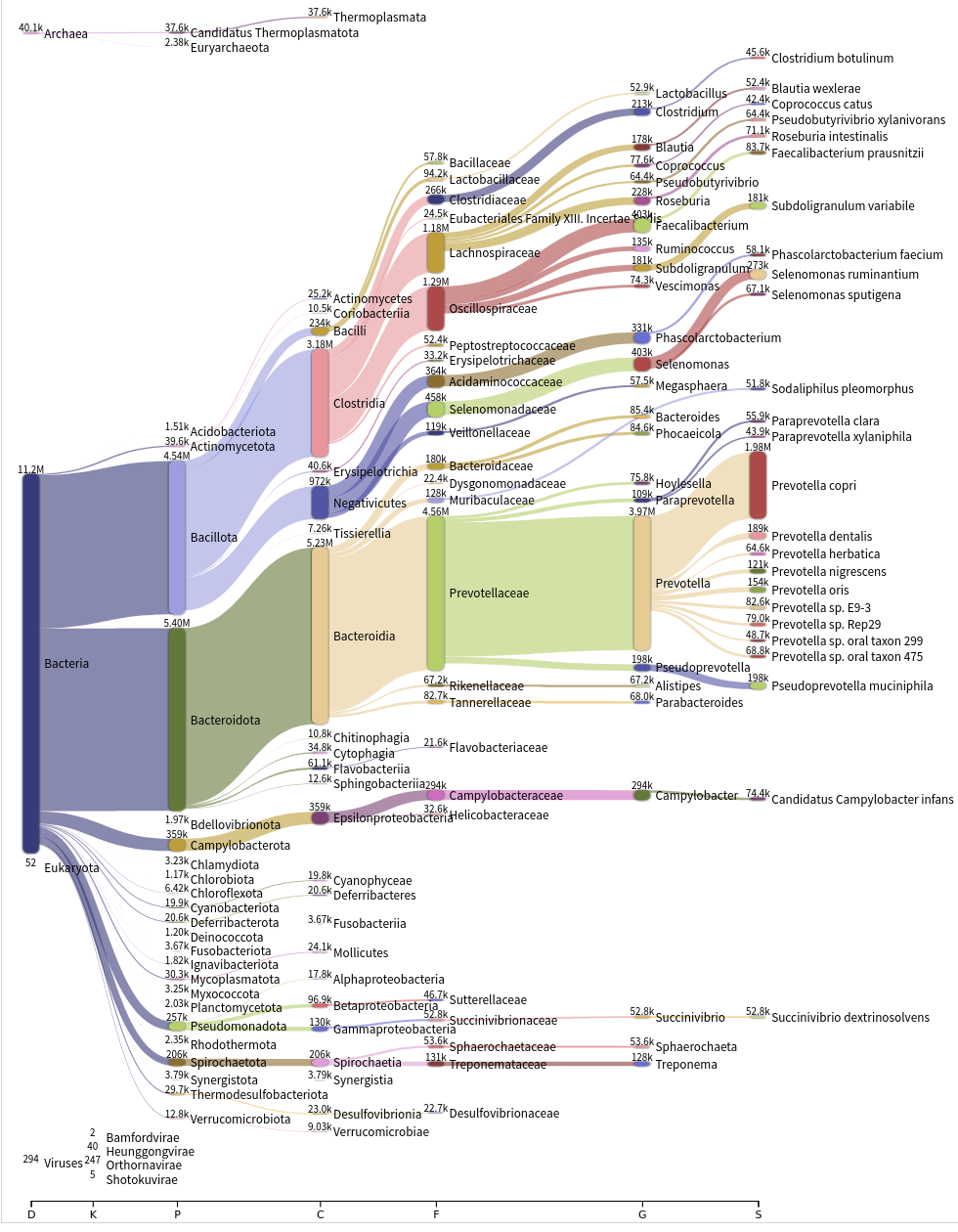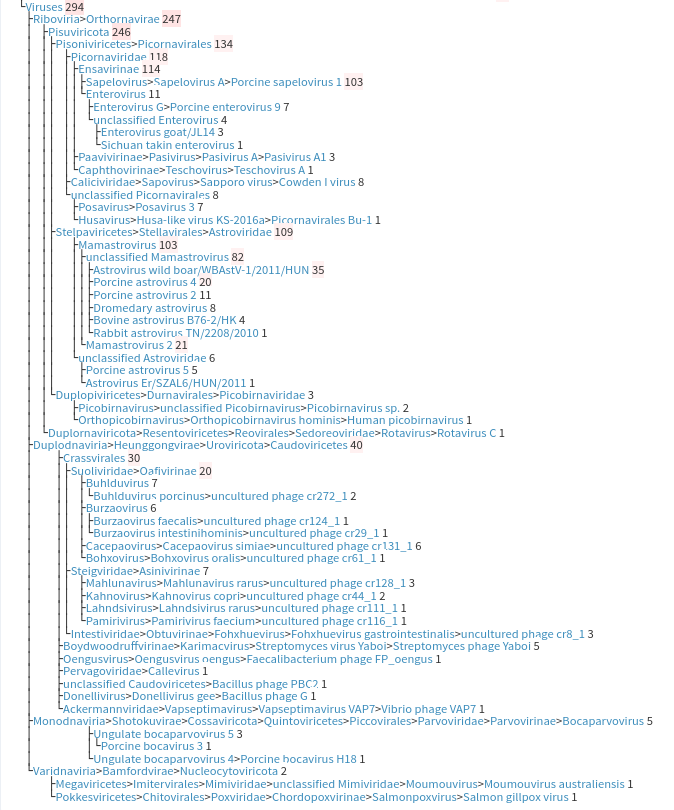Kraken2 Installation and Usage Guide
gene_x 0 like s 1819 view s
Tags: software, tool
kraken2 --db Minikraken2_v2 input_sequences.fasta --output output.kraken2
kraken2 --db=/home/jhuang/Tools/k2_standard_20230605 --output=A10_output.txt --report=A10_report.txt --paired ./results_ATCC19606/trimmed/A10_CraA_HQ_trimmed_P_1.fastq.gz ./results_ATCC19606/trimmed/A10_CraA_HQ_trimmed_P_2.fastq.gz
Kraken2 is a system for assigning taxonomic labels to short DNA sequences, such as those produced by genome sequencing technologies. It achieves high speeds by utilizing exact alignments of k-mers and a novel classification algorithm.
Here's a step-by-step guide to installing and running Kraken2:
-
Install Kraken2: Kraken2 is available on GitHub. You can use git to clone the repository and then compile it.
git clone https://github.com/DerrickWood/kraken2.git cd kraken2 ./install_kraken2.sh . #export PATH=/home/jhuang/Tools/kraken2:$PATH #git clone https://github.com/jenniferlu717/Bracken.git #./install_bracken.sh .This will install Kraken2 in the current directory.
-
Download or build a database: Kraken2 requires a database to classify sequences. You can either download a pre-built database or build one yourself. Download a pre-built database:
#https://benlangmead.github.io/aws-indexes/k2 wget https://genome-idx.s3.amazonaws.com/kraken/k2_standard_20230605.tar.gz #https://ccb.jhu.edu/software/kraken2/index.shtml?t=downloads #https://lomanlab.github.io/mockcommunity/mc_databases.htmlKraken2 provides some standard databases that can be downloaded. Here's how you can download the MiniKraken2_v2 database (8GB):
kraken2-build --download-library bacteria --db Minikraken2_v2 kraken2-build --download-library viruses --db Minikraken2_v2 kraken2-build --build --db Minikraken2_v2Or, build a custom database: Building a database requires sequence data in the form of FASTA files. Here's an example of building a bacterial database:
kraken2-build --download-taxonomy --db MY_DB kraken2-build --download-library bacteria --db MY_DB kraken2-build --build --db MY_DB -
Classify sequences with Kraken2: Once you have a database, you can use Kraken2 to classify sequences. Here's how you can classify a set of sequences in a file named input_sequences.fasta using the MiniKraken2_v2 database:
kraken2 --db Minikraken2_v2 input_sequences.fasta --output output.kraken2 #/home/jhuang/Tools/kraken2/kraken2 --db=/home/jhuang/Tools/k2_standard_20230605 --output=output.txt --report=report.txt --paired trimmed/Rotavirus_S3_R1.fastq.gz trimmed/Rotavirus_S3_R2.fastq.gz Loading database information... done. 11351299 sequences (3196.22 Mbp) processed in 562.717s (1210.3 Kseq/m, 340.80 Mbp/m). 11271104 sequences classified (99.29%) 80195 sequences unclassified (0.71%)This will produce an output file (output.kraken2) with the classification results.
-
Visualize results (Optional): Kraken2's output can be complex. Visualization tools, such as Pavian or Krona, can be helpful for interpreting the results. These tools provide interactive pie charts and other graphics that can assist in understanding the taxonomic classifications provided by Kraken2.
#upload /home/jhuang/DATA/Data_Rotavirus/report.txt to https://fbreitwieser.shinyapps.io/pavian/ /usr/bin/convert Screenshot\ 2023-09-12\ at\ 11-09-13\ Pavian.png -crop 980x1260+280+300 output.png
Notes: Ensure that you have enough disk space. Building and storing databases, especially comprehensive ones, can require a significant amount of space. Kraken2's speed and accuracy can be influenced by the size and content of the database. It's always a trade-off between classification speed and the breadth of taxa you wish to detect.
点赞本文的读者
还没有人对此文章表态
本文有评论
没有评论
看文章,发评论,不要沉默
最受欢迎文章
- Motif Discovery in Biological Sequences: A Comparison of MEME and HOMER
- Why Do Significant Gene Lists Change After Adding Additional Conditions in Differential Gene Expression Analysis?
- Calling peaks using findPeaks of HOMER
- Updating Human Gene Identifiers using Ensembl BioMart: A Step-by-Step Guide
- pheatmap vs heatmap.2
- Should the inputs for GSVA be normalized or raw?
- Setup conda environments
- PiCRUST2 Pipeline for Functional Prediction and Pathway Analysis in Metagenomics
- Kraken2 Installation and Usage Guide
- File format for single channel analysis of Agilent microarray data with Limma?
最新文章
- Stihl Elektro-Heckenschneider
- Processing Data_Tam_RNAseq_2024_MHB_vs_Urine_ATCC19606
- Workflow using PICRUSt2 for Data_Karoline_16S_2025
- Viral genome assembly and recombination analysis for Data_Sophie_HDV_Sequences
最多评论文章
- Updating Human Gene Identifiers using Ensembl BioMart: A Step-by-Step Guide
- The top 10 genes
- Retrieving KEGG Genes Using Bioservices in Python
推荐相似文章
Motif Discovery in Biological Sequences: A Comparison of MEME and HOMER
Workflow and Tools for Integrating ChIP-seq and RNA-seq Data Analysis

